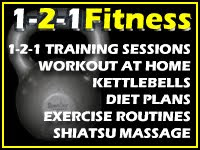
While literally millions of people workout, very few realize true workout success. Most dabble in the gym on and off, never getting results. They quit working out, usually under a myriad of excuses along the lines of being too busy or of disappointment that "they're just not seeing results".
Below are seven common reasons why workouts fail:
1) No clear goals -
If you can't measure it you can't manage it. Too many people head into the gym with either no thought of what they're trying to accomplish or vague goals of "losing weight" and "toning up".
What to do:
Be specific and write it down. If the goal is weight loss or body fat loss, identify how many pounds or the target weight, the time element, and what you'll do every day to make it happen. If it's muscle gain, identify things like desired bicep and chest measurements or one-rep max increases.
2) Motivation is missing -
Motivation has two key elements:
a) possessing a goal that is deeply meaningful to you, and
b) feeling mostly in control of the outcome.
If motivation is missing from your workouts, examine these two factors and identify what's missing. Why do you care about your goals? Do you feel you can make them happen or do you need help?
What to do:
Take stock of why you started working out and make sure the cause matters to you, and especially that you're doing it for yourself and not because someone else thinks you should.
Also, if you feel frustrated or even helpless about your ability to achieve the desired workout outcome, get help from a personal trainer and/or a nutritionist.
3) Fear of discomfort -
Let's face it, success in transforming your body requires some discomfort. This can be pushing weights until your muscles fail, upping cardio to uncharted heart rate territory, and dieting when the body tells you it must eat.
Many people fail in their workouts for the simple reason that they can't overcome discomfort.
What to do:
Discomfort is only a state of mind. Learn to recognize discomfort as only a mental barrier to your goal. Love your goal more than you dislike the discomfort.
4) Workout uncertainty -
In sports they say that a cloudy head makes for slow feet. With working out, especially in a gym, uncertainty about what exercise to do and about proper form can result in a tentative approach that lacks the intensity required for improvement and progression toward a goal.
What to do:
Don't go it alone, get the help of a professional trainer and then become a student of how to work out. Like anything else, the more you study it, understand it, and practice it, the better you'll become at it and the faster you'll improve. This usually results in increased enjoyment too.
5) No passion for results -
High achievers in the gym get jacked up about results that can be in the form of increased muscle strength, increased muscle size, and increased muscle endurance. Those that fail in the gym usually lack a vision of their future physical states and a burning desire to realize positive change
What to do:
Visual imagery can be a very powerful force. Look at fitness magazines or fitness sites and find examples of what you want to look like. One great site for this is BodySpace on Bodybuilding.com. Learn what it takes to achieve the look you're after, visualize yourself looking like that and then only do things that will get you there.
6) Missing the diet equation -
Whatever your reason for working out, you won't get there without the proper diet and nutrition. And absolutely don't make the mistake that "cardio" will effectively substitute for diet discipline because it won't. Depending on your goal you'll need a specific calorie target and the correct mix of lean protein, low-glycemic carbohydrates, and healthy fats.
What to do:
Study some good books on diet and nutrition, especially related to fitness. Better yet, to get jump started hire a nutritionist or a good personal trainer that can teach you the right ways to eat and strategies for managing you diet under the stress of every day life.
7) Making workouts drudgery instead of uplifting fun -
If it's not fun you won't do it. Too often people see their workouts as a kind of punishment for being out of shape, and that workouts are to be endured rather than celebrated.
What to do:
Make workouts your personal time to get away from life's stresses and to work up a great endorphin release. Workout in a place you like to be in. This could be in the gym or in the garage.
If you don't like your gym, shop around for one that feels like someplace you look forward to being at. View your workouts as a fun investment in yourself where you get to move closer to that future "you".





